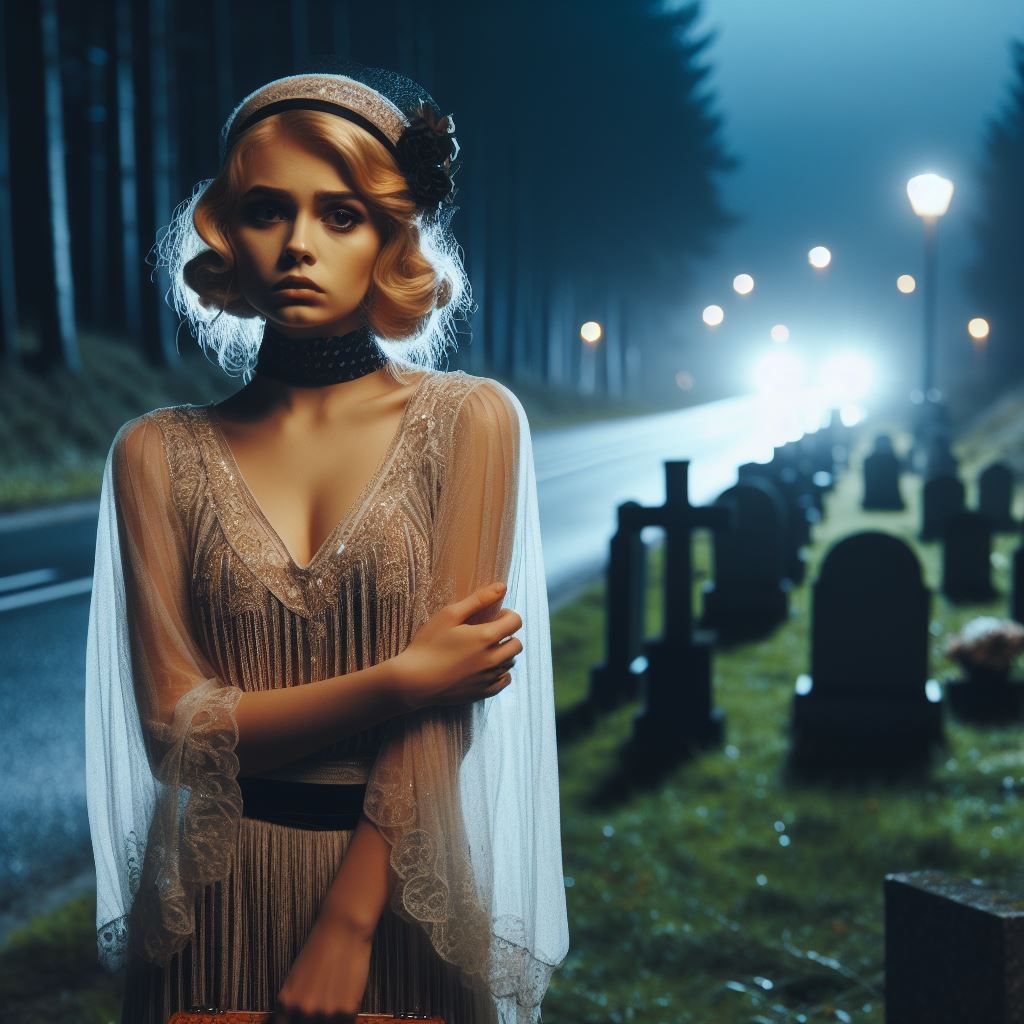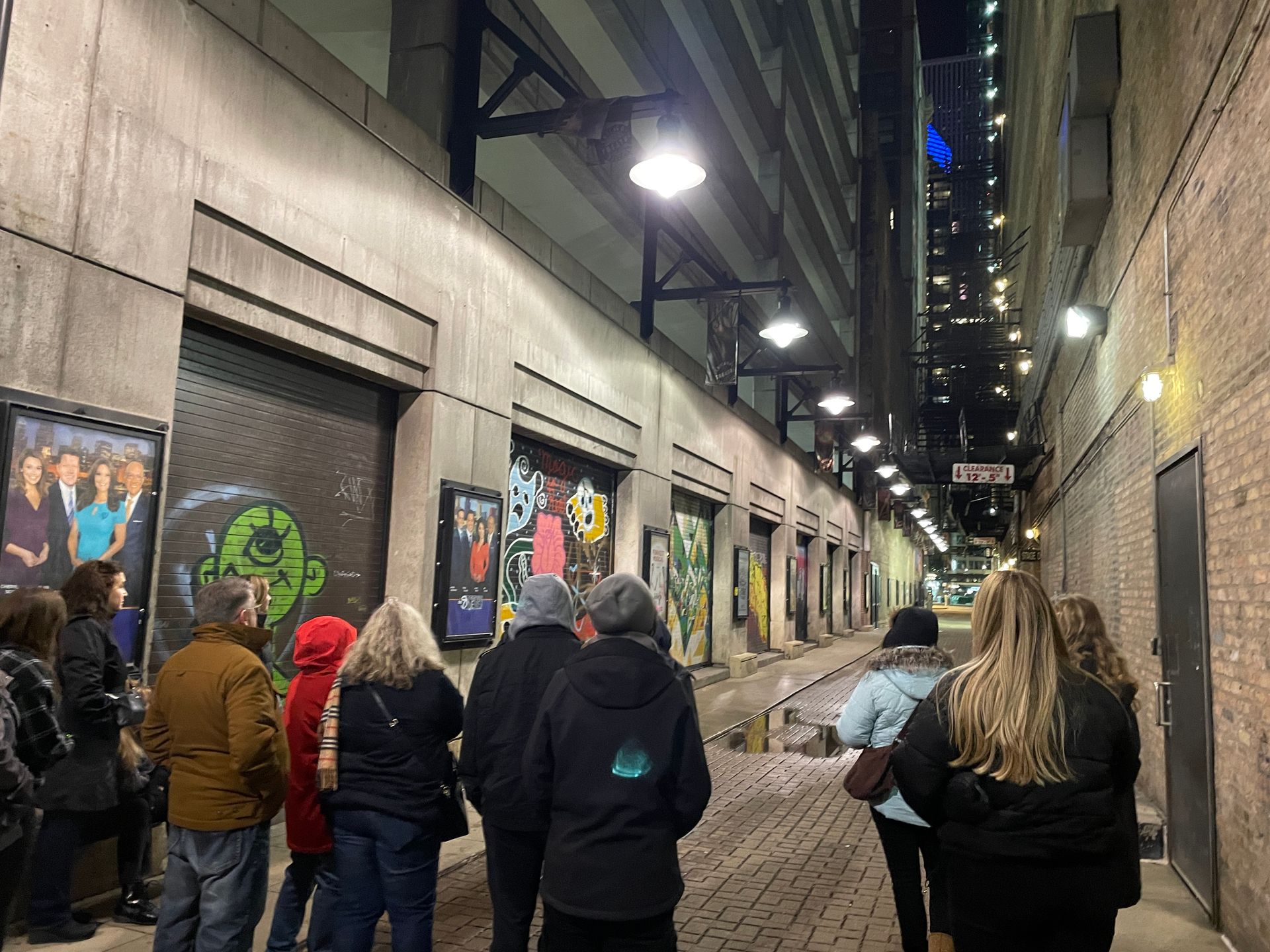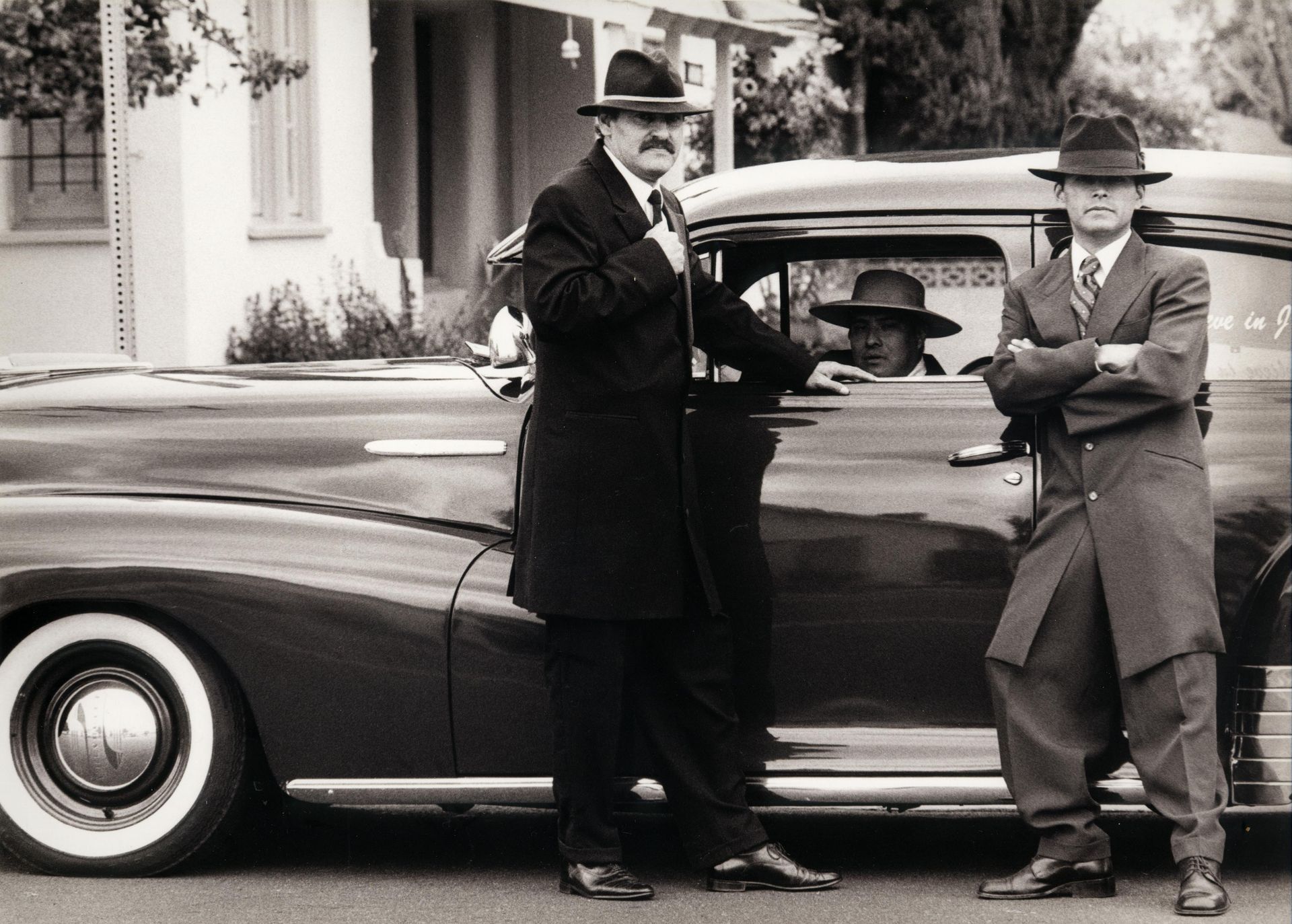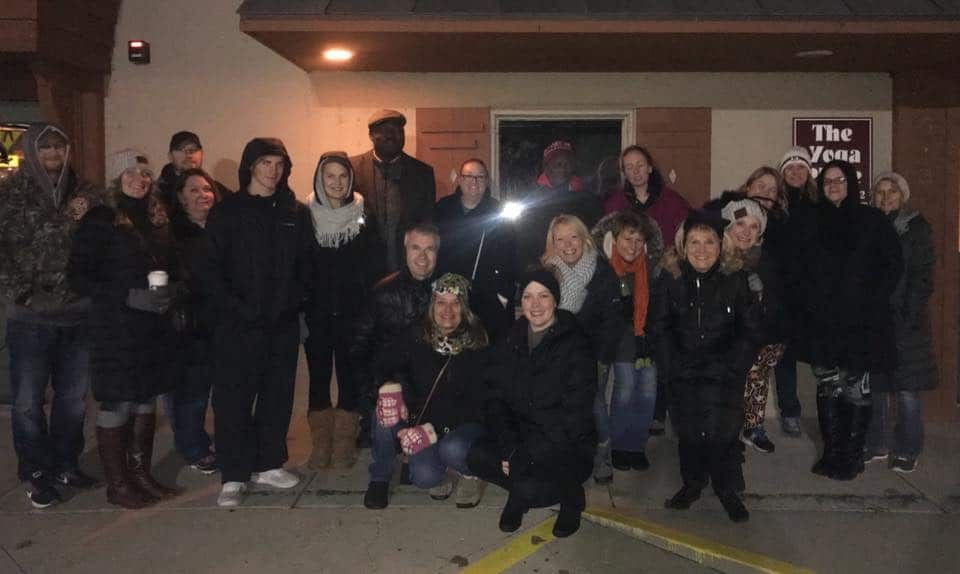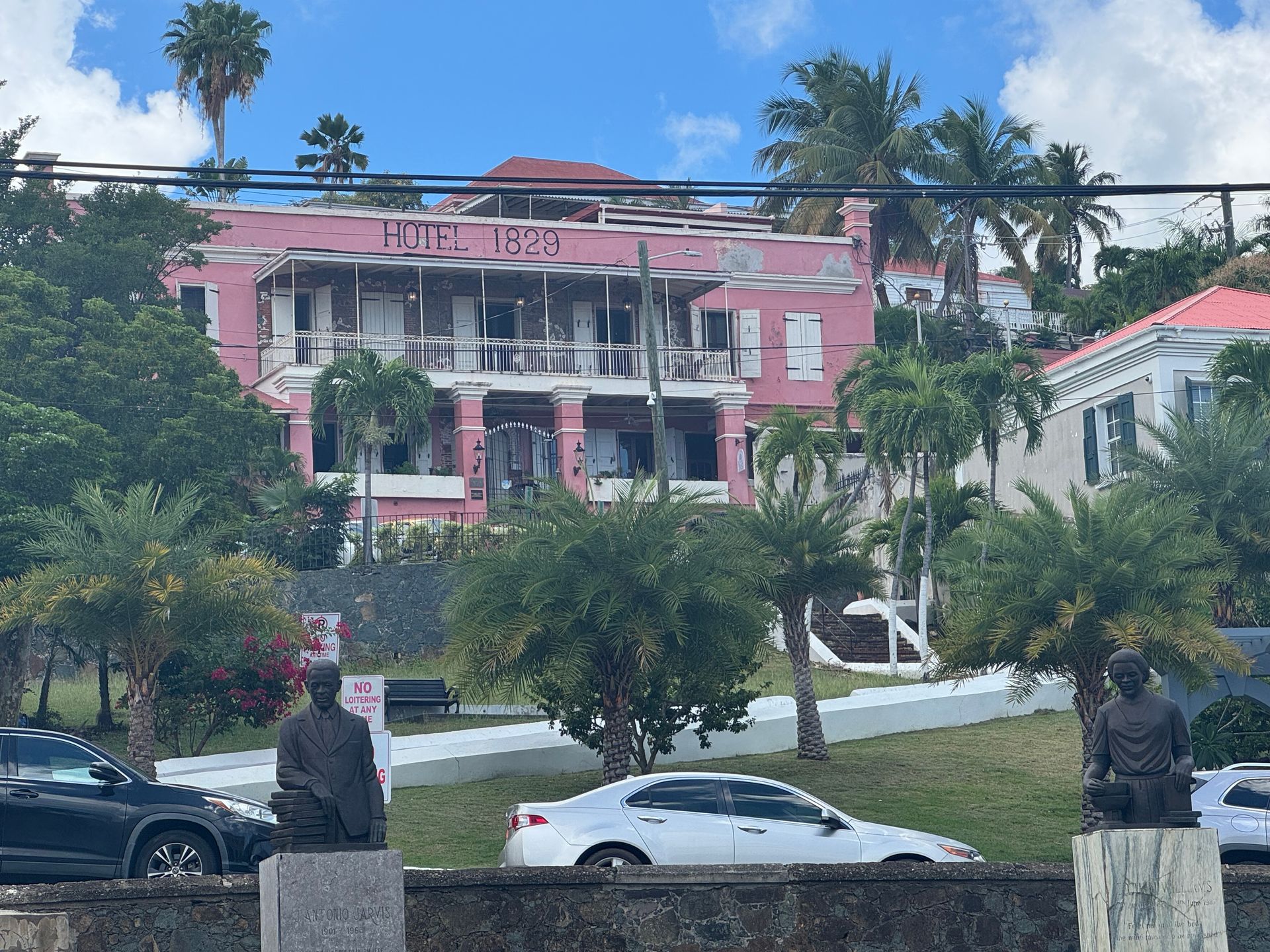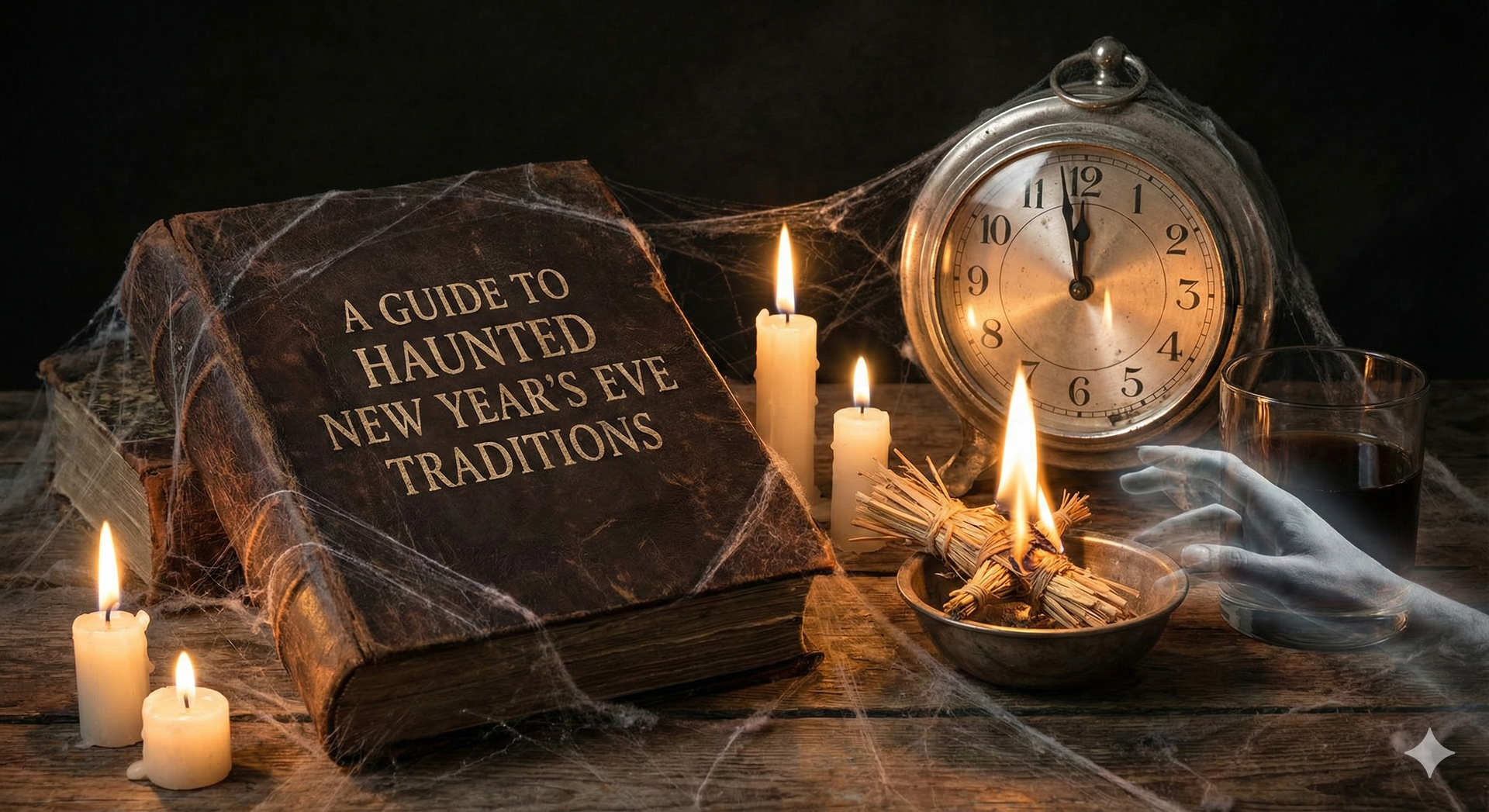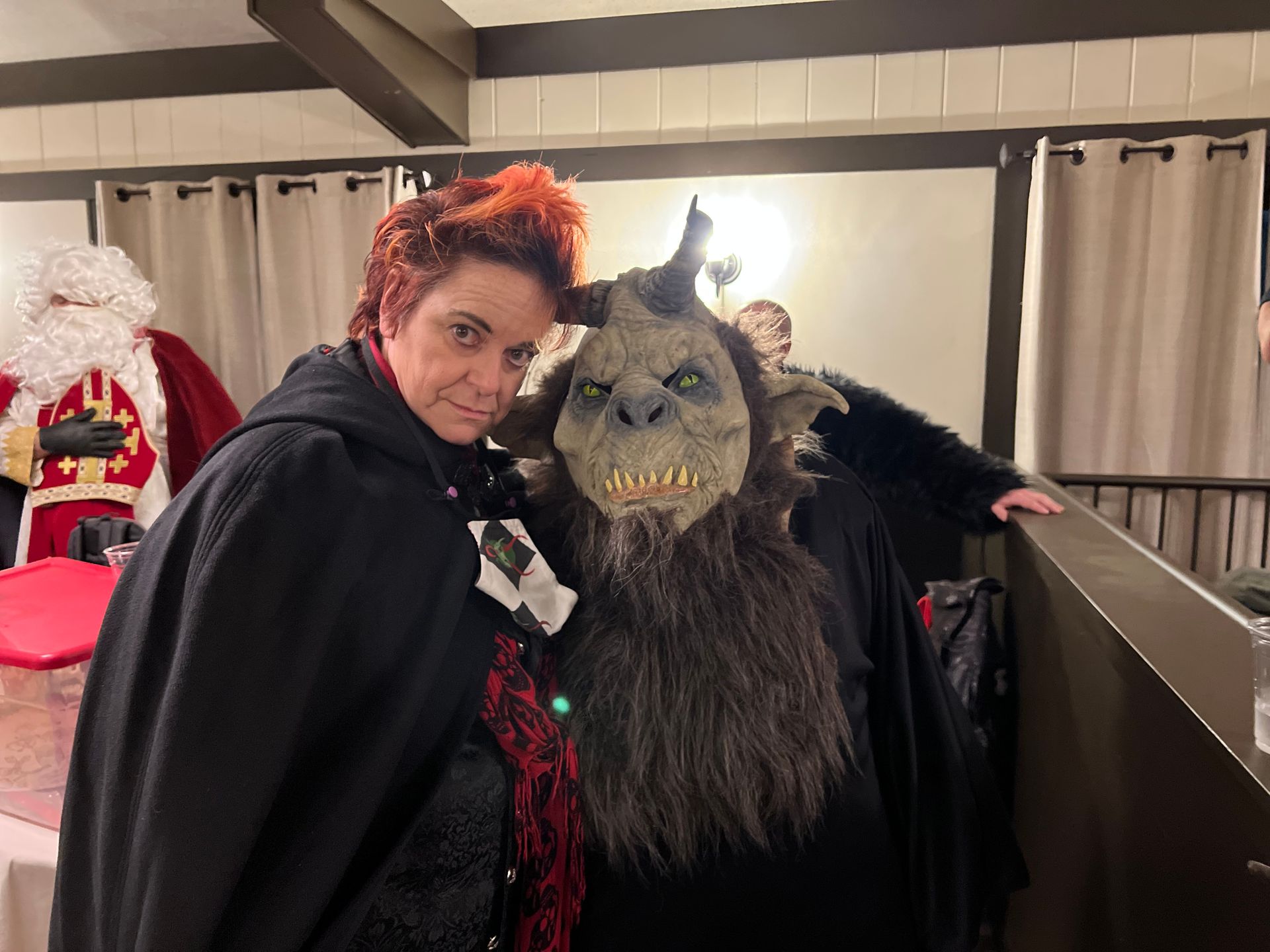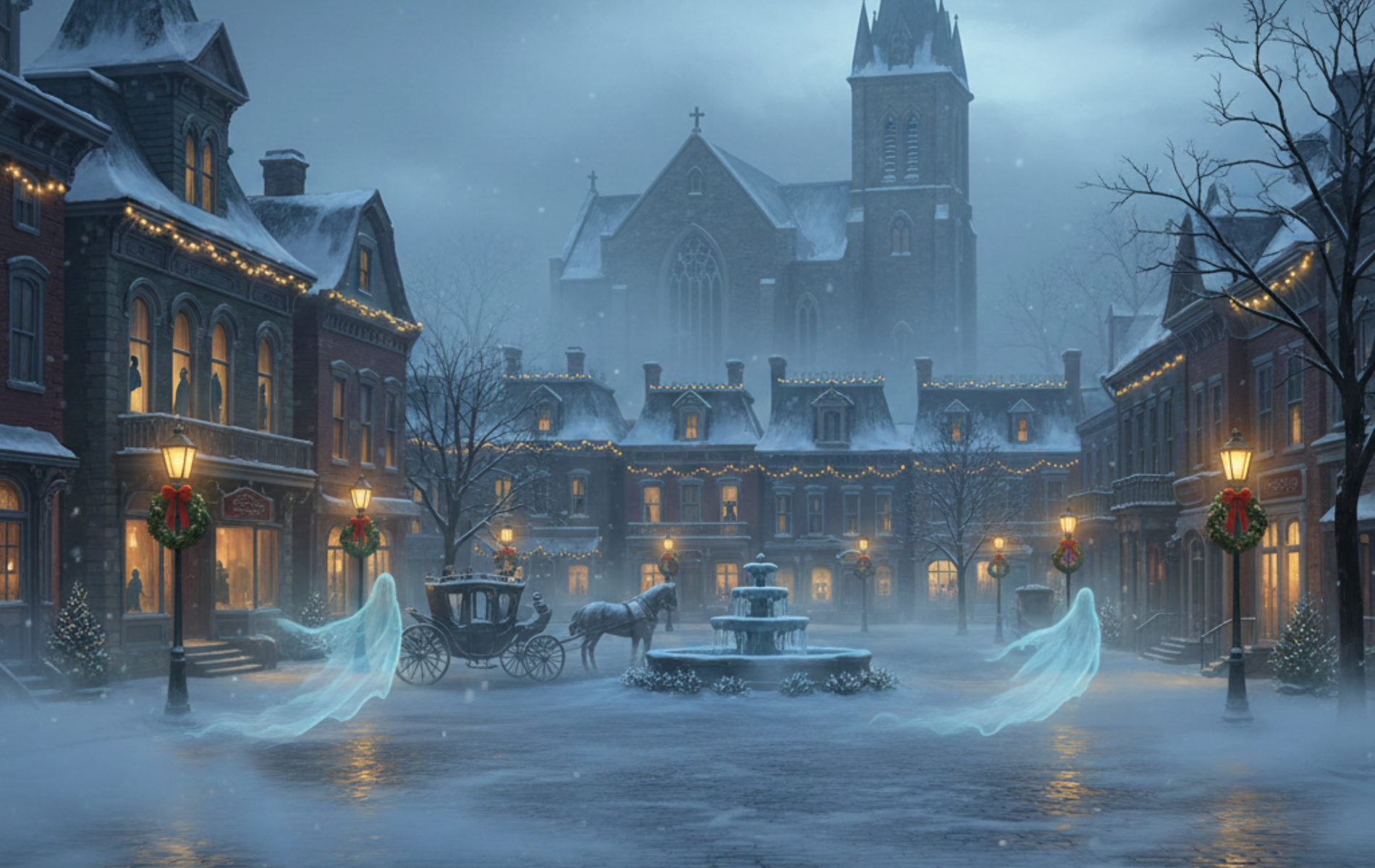Resurrection Mary: the Queen of Chicago's Haunted Archer Avenue
Few ghost stories are as famous — or as chilling — as the tale of Resurrection Mary, the mysterious hitchhiker who haunts Archer Avenue in Chicago. Known as the Queen of Chicago’s haunted roads, her legend has terrified drivers and fascinated ghost hunters for nearly a century.
The Story of Resurrection Mary
The tale begins on a cold Chicago night in the 1930s. A young woman, dressed in white, left the Willowbrook Ballroom after a night of dancing. She walked along Archer Avenue, attempting to hitch a ride home.
Since then, countless drivers have reported picking up a pale young woman on the roadside — only for her to vanish into thin air near the gates of Resurrection Cemetery in Justice, Illinois.
The Real Mary – Was It Mary Bregovy?
Some believe Resurrection Mary was inspired by Mary Bregovy, a 20-year-old Polish-American girl killed in a tragic 1934 car accident. While her grave is at St. Casimir Cemetery in Chicago, many think her spirit took on a new identity as the ghost of Archer Avenue.
Others argue the legend represents more than one victim of roadside accidents, blending tragedy into Chicago’s greatest
urban legend.
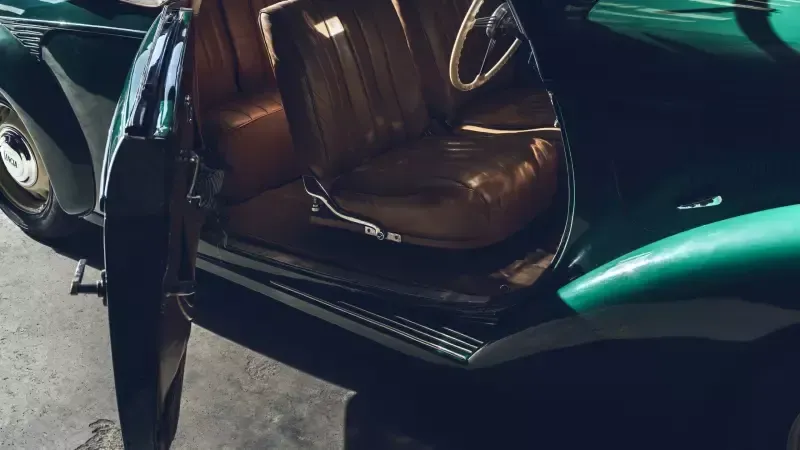
Archer Avenue – Chicago’s Most Haunted Road
Stretching through the southwest side of Chicago, Archer Avenue has a reputation for being one of the city’s most haunted streets.
Notable landmarks include:
- Willowbrook Ballroom – where Mary was last seen alive
- Local taverns and roadside stops where drivers claim to have seen her
- The gates of Resurrection Cemetery, where her ghost often disappears
Resurrection Cemetery in Justice, Illinois
The heart of the legend is Resurrection Cemetery, a Catholic burial ground in the village of Justice, IL.
Here, visitors have reported seeing:
- A young woman in white walking among the gravestones
- Glowing apparitions near the cemetery gates
- Burn marks on the iron bars where Mary’s hands supposedly gripped before vanishing
Today, Resurrection Cemetery is not only a place of mourning but one of the most haunted cemeteries in Chicago.
Ghost Sightings and Chicago Urban Legends
For decades, locals have shared stories of:
- Dancing with Mary at the Willowbrook Ballroom
- Picking her up on Archer Avenue late at night
- Watching her disappear at the cemetery gates
These tales place her alongside legends like Bloody Mary and other Chicago ghost stories, cementing her status as the city’s most famous phantom.
Resurrection Mary in Pop Culture and Unsolved Mysteries
The ghost’s fame grew nationwide after being featured on Unsolved Mysteries and other paranormal shows. She has been called America’s most famous hitchhiking ghost, inspiring books, films, and countless ghost-hunting tours.
Experience Resurrection Mary on a Chicago Ghost Tour
Want to encounter Mary yourself?
Join one of our Chicago Ghost Tours and:
- Drive along Archer Avenue, Chicago’s most haunted road
- Visit Resurrection Cemetery in Justice, IL
- Hear chilling retellings of Chicago’s most famous ghost stories
👉
Book your tour today and walk in the footsteps of Resurrection Mary.

Ana’s Deadly Night at the Oh Henry Ballroom
By the time she neared her teenage years, Anna had grown into a vivacious girl. Blonde and slim, she loved to dance, and it was her relentless begging that convinced her father, August, Sr., to take her to a dancehall for her 13th birthday. On the evening of July 20, 1927, father and daughter set out from their Chicago home at 5421 S. Neva for the famous Oh Henry Ballroom, accompanied by August's friend, William Weisner, and Weisner's date. On their drive home, at approximately 1:30 a.m., the travelers passed Resurrection Cemetery via Archer Avenue, turning east on 71st Street and then north on Harlem to 67th Street. There, the car careened and dropped into an unseen, 25-foot-deep railroad cut.
Ana was killed instantly.
After the accident, her father, August Norkus, was subject to devastating verbal abuse, even being told that Anna's death had been God's punishment for allowing the girl to go dancing at such a young age. In reality, the blame rested with the Chicago Streets Department, which had failed to post warning signs at the site of the cut. Another death, that of Adam Levinsky, occurred at the same site the night after Anna's demise.
Between July 28th and September 29th, an inquest was held at Sobiesk's Mortuary in adjacent Argo. Heading up the five sessions was Deputy Coroner Dedrich, the case reviewed by six jurors. The DesPlaines Valley News carried the story of the inquest. Mary Nagode described the sad procession that left the Norkus home on a certain Friday morning.
First in line was Ana's older sister Sophie, followed by her older brother August, Jr. The pastor, altar boys, and a four-piece brass band preceded the casket, borne on a flatbed wagon with pallbearers on each side. Relatives and friends followed the grim parade for three blocks to the doors of St. Joseph's in Summit, where Anna had made her first communion only a year before. Between the band and the priest walked a terrified Mary Nagode, a friend of Ana's who had been pressed into service as a wreathbearer.
On summer vacation, Nagode was weeding on an asparagus farm in Willow Springs when she had a visitor. It was Gus Norkus, Ana's father or brother, asking her to participate in the funeral since Mary had made her first communion with Anna and owned a white dress. When Mary returned home that evening, her mother informed her that she had accepted the request on her behalf. The girl was deeply dismayed at the proposition. Mrs. Nagode reminded her daughter that refusal of such a request would be a sin against Roman Catholic moral living, which dictates that one must attend to the burial of the dead.
Anna was scheduled for burial in one of three newly-purchased family lots at St. Casimir Cemetery, and it is here where Andrejasich, Nagode’s cousin, found the "if' that may have led to an infamous afterlife for Ana as Resurrection Mary, or as Anna called herself, Marija.
Andrejasich Connecting Resurrection Mary to Anna
Andrejasich discovered that at the time of Ana's death, a man named Al Churas Jr., brother-in-law to Mary Nagode, lived across the road from the gates of Resurrection Cemetery in a large brick bungalow that still stands today. Al's father was in charge of the gravediggers and was given the house to live in as part of his pay. In the mid-1920s, gravedigging was hard, manual labor, rewarded with low pay. Strikes were common. As Resurrection was one of the main Chicago cemeteries, the elder Churas was often sent to the cemeteries of striking gravediggers to secure the bodies of the unburied.
Returning to Resurrection with a corpse in a wooden box, Churas' duty was to bury it temporarily until the strike ended and the body could be permanently interred in the proper lot. Because of poor coffin construction and the lack of refrigeration, a body could not be kept long, except in the ground.
If the strike dragged on, identification at the time of relocation could be gruesomely difficult. Thus, reasons Andrejasich, if the workers at St. Casimir were striking on that July morning in 1927, it is quite possible that young Ana Norkus was silently whisked to a temporary interment at Resurrection and that a rapid decomposition rendered her unidentifiable at the time of exhumation. The result? A mislaid corpse and a most restless eternity, if only one is willing to believe.
Those not quite convinced may be persuaded otherwise by a further bit of Frank's musing, this time connecting the otherworldly Anna to the sneering specter seen on the road outside of her alleged resting place. The elder August Norkus followed his youngest child to St. Casimir 30 years after her death, a broken man besieged by alcohol and blamed to his grave for his daughter's demise. As Andrejasich reasons, it wouldn't take much else to make a ghost out of this ill-fated character. And yet, how much more there is (again, if only one believes in ghosts) if Ana was mistakenly buried away from her family?
For here, the stories merge almost too easily. The resulting image is classically and completely appealing: Resurrection Marija combing the southwest suburbs for her kin, her father wandering the road outside her unknown destination, watching and waiting for his lost beloved.
Research & Opinions on Resurrection Mary
Despite widespread belief in such scenarios and the untiring work of devoted researchers like Frank Andrejasich, specialists in modern folk tales have utterly disregarded local attempts to trace Resurrection Mary to any earthly counterpart. Instead, many scholars explain Mary as merely a localized version of the widespread vanishing hitchhiker legends.
These legends have passed from generation to generation throughout history, but the 20th-century versions always follow a strikingly similar pattern. A hitchhiker, usually a young woman, is either picked up along a dark road or met at a dance, from where she is given a ride home. In the latter situation, her would-be suitor may report having danced with the young woman, finding her somewhat cold.
In both situations, she gives her escort vague directions to her house, but along the way she suddenly vanishes from the car. Sometimes, the driver will have procured her address and proceed to the house to ask whether the girl has returned safely home. Upon his arrival, he is told that the girl, whom he recognizes in a photograph displayed in the home, was previously killed in a car accident on the road or near the dance hall where she met her unfortunate escort.
The Resurrection Mary stories bear an uncanny resemblance to these widespread tales. Accounts of Mary by eyewitnesses have conformed to the universal model even more perfectly than do most second-hand legends. However, the existence of so many first-hand reports raises questions about the assertions that Mary is mere folklore.
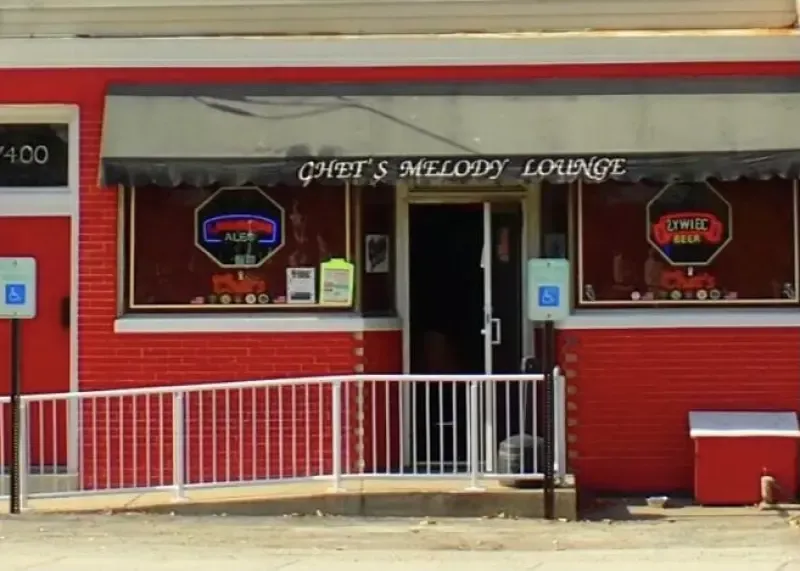
Mary’s Increased Restlessness in the Mid-1970s
Reports of Resurrection Mary increased significantly during renovations of the cemetery in the mid- 1970s. It was also around this time that the phantom began to become more animated . . . and adventuresome.
In 1973, Mary is believed to have shown up at least twice in one month at a far Southwest-side dance club called Harlow's, 8058 S. Cicero Avenue, wearing a dress that looked like a faded wedding gown. A Harlow's manager described her as having "big spooly curls coming down from a high forehead. She was really pale like she had powdered her face and body." Dancing alone in off-the-wall fashion, she was as obvious as could be, yet, despite bouncers at the door who carded all guests, no one ever saw her come in or leave.
That same year, at Chet's Melody Lounge, an annoyed cab driver bounded in asking about his fare, a young blonde woman. The manager gave him the only answer he had: "A blonde woman never came in here."A number of years later, a driver happened to be passing the cemetery when he glimpsed a young woman standing on the other side of the gates, clutching the bars. Worried that someone had been locked inside after closing, he hurried to report the incident to the local police, who hastened to rescue the reluctant prisoner.Upon their arrival, they found the cemetery deserted, but their inspection of the gates revealed a chilling spectacle: not only had two of the bars been pried apart, but the impressions of a pair of delicate hands remained, bearing witness to the feminine touch that had accomplished the task.
When cemetery management saw the state of the bars, they reportedly called in officials from the Archdiocese of Chicago, who allegedly removed the imprinted bars and whisked them away. Akin to stories of aliens in warehouses are local whisperings about the mysterious bars sitting today in some secret Archdiocesan storehouse. Not long after the removal of the damaged bars, embarrassed cemetery officials installed what they called "repaired" bars, insisting that the bent bars had been welded back to normal and not, as many asserted, replaced with new ones.
Still, some cemetery workers maintain that the bars were bent by a crew member's truck backing into the gate; the handprints were left by a worker's glove when he attempted to heat the bars with a blowtorch and bend them back into shape. In response to that claim, local believers say: Yes, the cemetery tried to blowtorch and restore the bars, to eradicate evidence of the spectral handprints, which witnesses continue to describe as the well-defined fingers of a frail female.
Whatever the claims, the tale's undeniable fascination lies in viewing the cemetery gates even to this day, as two strips of discolored metal remain in the exact spot which once bore the mysterious handprints. In fact, and there seems to be no reason to doubt the rumor, it is said that this part of the gate refuses to "take" either primer or paint.
The result? An embarrassing but ineradicable scar on the face of the cemetery and its management. (Note, in the late summer of 2019, the two bars disappeared from the gate of Resurrection Cemetery. It is unknown at this time if they were removed by the Archdiocese or if they were stolen.)
As if this carnival weren't enough for the cemetery to bear, it was also around this time that Resurrection Mary began to experiment with new methods. Folklorists have described a certain model of the phantom hitchhiker which is best termed the "spectral jaywalker," that is, the ghostly vision that walks or simply appears in front of a moving vehicle.
One such story tells of a Justice police officer who called an ambulance after hitting a woman in a bloody white dress who was wandering the road in front of the cemetery. When the paramedics arrived on the scene, there was no trace of the distressed woman. According to some stories, the officer in question went on the nationally syndicated television show, "That's Incredible!" and told of his experience. Before doing so, he was warned that he would be fired if he did. Notwithstanding the alleged threats, the officer told his story to network audiences and was at least by local accounts relieved of his duties.
Paranormal Accounts Stabilizing in the mid-1980s
After a bizarre decade that seemed to mark the climax of her restlessness, Mary was back to her old tricks. Yet she didn't seem quite her old self. In 1989, on a blustery January night, a cab driver picked up a desolate young woman outside the Old Willow Shopping Center. Despite the inclement weather, she wore a beautiful white party dress and patent leather dancing shoes.
Climbing in the front seat, she made it clear that she needed to get home, motioning the driver up old Archer Avenue. But this time she behaved differently. She seemed confused, unable to give lucid answers to the cabby's polite questions. Finally, with all the clarity she could muster, the girl remarked, "The snow came early this year." Then, in front of a time-worn shack across the road from Resurrection, the disoriented passenger ordered, "Here!" disappearing without another sound.
Account of a Dancing Resurrection Mary at Christmastime
Also in the late 1980s, two teen-aged boys were driving along Archer Avenue at Christmastime when they saw a strange woman dancing down the road outside the cemetery fence. They noted that other passers-by seemed totally unaware of her antics; in fact, they didn't seem to see her at all. The teens reported the bizarre scene to their parents, who at once related the famous tale of Resurrection Mary. Never having heard the story before, the boys must have questioned whether the off-the-wall vision they had seen was the same as the legendary hitchhiker, whose aloof sophistication seemed wholly unbefitting the wacky wayfarer of their own experience.
Who Has Resurrection Mary Become
What has happened to Resurrection Mary in these past decades? A ghosthunter's classic summation would point to the disruption of the Bregovy grave during cemetery renovations. Investigators might theorize that this disruption could have caused Mary's apparent disorientation. Possibly. For, although the site of the grave was finally disclosed to the public after many years of secrecy, the plot turned out to be unmarked.
Mary Bregovy's was a "term grave," a plot that was sold on 25-year terms during the '20s and '30s, in a section of Resurrection that was renovated during the '60s and '70s. It is, therefore, possible that the girl's family either did not repurchase the grave, resulting in the filling-in of the plot or that they or the cemetery administration moved the grave to discourage the curious.
There is one other peculiarity worth noting. Resurrection Mary has traditionally been connected with the former Oh Henry (Willowbrook) Ballroom, where she is alleged to have danced during her lifetime, and where she is guessed to have danced her last.
Some accounts, however, specify that on the night of her death, Mary was at a dance for Christmas or even Advent, the Christian season preceding Christmas. The fact that so many Resurrection Mary encounters occur in December might seem to render this obscure lore somewhat more credible, although the timing would also undermine the connection to the Mary Bregovy who was killed on March 10th. Dealing only with conjecture about the behavior of ghosts, researchers continue to seek the Bregovy grave at Resurrection Cemetery in hopes of finding some end to a grueling but engaging search.
Resurrection Mary’s Evolving “Personality”
Whoever Resurrection Mary is, and whenever she may materialize, the apparent changes in this legend's "personality" continue to present a nagging appeal to the folklorists who have denied that Mary has any psychic reality, and who have accordingly classified her with other bizarre by-products of the oral tradition. With good reason.
One "lost" haunting, which is supposed to have occurred in the late 19th century at St. James-Sag Cemetery at the southern end of Archer Avenue, curiously parallels the Resurrection Mary story. In fact, the two legends share a great number of specific elements, including the singular image of a woman in white waiting for a ride in front of a dance hall on Archer Avenue.
Ultimately, regardless of the temptation to give in to folkloric categorization of Mary, the primary difficulty remains: a good number of first-hand accounts of these encounters have been recorded. In the case of urban legends like that of the vanishing hitchhiker, the incidents are supposed to have occurred to "a friend of a friend" or someone's "boyfriend's mother's friend" and so on. If we accept the first-hand accounts of this hitchhiker at face value, the phenomenon of Resurrection Mary continues to challenge the most skeptical observers and to lure the most hopeful believers to her stomping grounds.
Susan Stursberg was one of the latter who decided to try her luck at spotting the famed and filmy form. Her account is unique in this author's experience, and deserves retelling:
I was out with a friend one night who had just bought a new car. I had not been to Archer Avenue and was itching to go, so we decided to take a drive. First we stopped to see her boyfriend who was playing in a band at a nearby suburban bar. We said hi, told him we were going for a drive but did not tell him where. So we proceeded to Chet's Melody Lounge, talked to the regulars, played "The Ballad of Resurrection Mary" on the jukebox and some pool. We left in a couple of hours when 2 a.m. rolled around, drove to the cemetery gates, parked and peered in, seeing the repaired gates and getting a good case of the creeps. On the way home we joked about giving Mary a ride in the new car. Later that night my friend, Kristin, dropped me off at my apartment and went home to hers.
As her boyfriend, Mike, heard the car pull up he peeked out the window, then not wanting to appear worried and waiting up he dropped the shade. Kristin let herself in and closed the door. Mike asked, "Where's Susan?" Kristen told him that she dropped me off first. He asked, "Well, who was in the car with you?" To this day he swears that when he looked out the window he saw a pale face look back at him from the passenger's side of the front seat.
Despite such compelling accounts as this and those others detailed in these pages, the doubters stand fast. Among them are those extreme locals like Gail Ziemba, who lives across the road from Resurrection Cemetery. Easily summing up her 20 years of experience with the legendary ghost, Ziemba maintains: "I've never seen anything." In response, believers would remind her that only men are privileged to see Resurrection Mary, although there have been cases in which a man and a woman traveling together have both reported a glimpse or two of something.
And while neighbors like Ziemba continue to shake their heads at the legend, other neighbors of the cemetery have been pushed to reconsider their doubt. Early one morning in late summer of 1996, Chet Prusinski himself, owner of Chet's Melody Lounge, was backing out of his driveway when a man came rushing across the road, yelling that he needed a phone.
He had hit a woman on Archer Avenue and couldn't find the body. Attesting to his claim was a truck driver who had been driving behind him. He, too, had witnessed the grisly incident and remained at the scene to testify on the woman's behalf. Prusinski agreed to call the police, but hastened to disengage himself from the whole affair, fearing that he would be accused of staging a publicity stunt for his bar. The "accident" was quietly resolved and little was made of the event. However, those who always take note, took note. And, of course, those who always laugh, laughed.
Yet, even those Southwest-siders who discredit Resurrection Mary know that much of what makes their culture special is wrapped up in the folds of her legendary white dress. And because of this, she is, even to nonbelievers, a priceless treasure, just as she was to a fictionalized witness in Kenan Heise's novel, " ... something precious, whoever or whatever she is. . .. To her, I say, 'God bless you.'"
The Fortean Times’ Vanishing Hitchhiker
In a 1997 article for Fortean Times, a magazine devoted to the probing of baffling occurrences and related theories, Sean Tudor offered some further insights into the phenomenon of the so-called "road ghost" as he explored the phenomenon of the infamous phantom of Blue Bell Hill in Kent, England. As Tudor states at the outset of his analysis, "(I)t is to folklore that we must tum to gain any kind of understanding of what is really happening" in such cases. Indeed,
(t)he same PHH (Phantom Hitch-Hiker) script is repeated around the country and indeed the world with an identical pattern of events being reported over and again by reliable witnesses: of figures rushing into the paths of vehicles, and/or of disappearing hitch-hikers ... which suggests that it has less to do with any specific case and its accepted explanation ... but, at the same time, more than purely 'human' factors such as imagination and hoaxing.
In the case of Blue Bell Hill, one of the spirit's manifestations is that of a young woman in white, who has been known to appear in front of moving cars, staring calmly at their drivers while she is run over. Like Chicago researchers who trace their Resurrection Mary to any of a half dozen 1920s and '30s accident victims fitting her description, residents of the Kent region almost always tie their road ghost to a 1965 incident in which three young women were killed in a car crash on Blue Bell Hill just hours before one of the girls was to be married.
Highly skeptical of the connection, Tudor has his own theories concerning the "haunting" of Blue Bell Hill. One of the most intriguing is the relation of the story to that of the Cailleach of pre-Celtic mythology, an Earth mother or goddess who variously took the form of an old crone or a beautiful young woman. The Cailleach is known as a guardian of a particular sacred place, and it was Tudor's awareness of this mythology that allowed him to notice in his own research that great increases in road ghost sightings, including those at Blue Bell Hill, have occurred during times of environmental upheaval, especially during the construction of roads and highways.
With this in mind, Chicagoans might ponder the fact that the building of Archer Avenue over an old Indian road, not to mention the digging of the Illinois and Michigan Canal which it preceded, seemed to coincide with the beginning of that road's extraordinary supernatural history, a history which features one of the most famous of all road ghosts, the blonde-haired and beautiful young woman known as Resurrection Mary.
Another of Tudor's compelling explanations for the sighting of road ghosts goes back to the subjectivity of the witness himself. Referring to Carl Jung's Man and His Symbols, Tudor reminds us of Jung's theory that the unconscious typically manifests itself in the dream state, and often symbolically, as a figure of a woman or man.
The specific form taken depends on the gender of the dreamer. A woman's unconscious, then, usually resembles a man (animus); accordingly, in the dreams of men, the unconscious generally takes the shape of a woman or (anima). In light of the fact that the overwhelming majority of sightings of young and beautiful phantom females, including those of Resurrection Mary, are reported by men, it is almost easy to believe that the dreamlike state imposed by lonely late-night driving could be the culprit in so many of these cases.
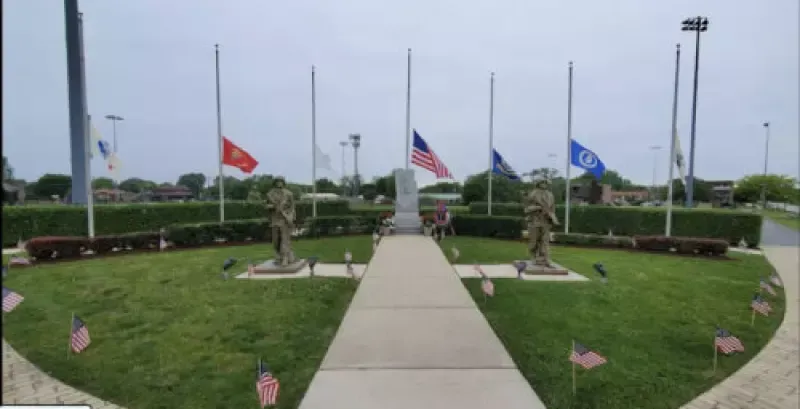
Why Archer Avenue?
Still, despite the temptation to dismiss the complex paranormality of Archer Avenue as simply a jumble of various renditions of some ancient and unfounded ghost stories, the continuing reports of eyewitnesses defy attempts to dismantle this road's reputation. And so, some, trusting in more than a century of experiential accounts, have tried to find an explanation for the seeming concentration of paranormal activity along Route 171.
Archer Avenue: an Old Indian Trail
Theories abound, most based on the area's geography. Archer Avenue was originally one of a number of the Chicago area's old Indian trails; accordingly, I’ve long wondered if the road may be an American example of a “ley” line. The concept of ley lines originated in Britain when Alfred Watkins, a retired brewer, noticed that the English countryside was covered by long tracks, which he termed leys ("lea," meaning "meadow"), which intersected at various points.
Watkins' 1925 book on ley lines, The Old Straight Track, drew quite a following upon its release, creating a breed of researchers ("ley hunters") who began to locate and map these leys. The points at which two or more ley lines meet were later termed nodal points. Observation of these nodal points led some researchers to believe that such crossroads were, in fact, ancient sacred sites. Many ley hunters came to assert that these nodal points/sacred sites often host extraordinary phenomena and that equally mystifying events also can occur along the lines that connect them.
Archer Avenue: Derived Energy from Underground Springs’ Nodal Points
Later, Guy Underwood, a dowser, claimed to have discovered that these points contained underground springs, which seemed to create patterns of spiral lines of "force" around them. He also found straight lines of this same force, which he termed holy lines, passing through these sites. Occult investigator Stephen Jenkins speculated that poltergeist activity and other haunting phenomena may actually take their energy from nodal points. Like-minded observers have wondered if ancient cultures—including Native Americans—hoard an awareness of these energies and utilized them as sacred paths and sites for their ritual activity.
Covering similar ground is ET. Stringer's concept of Tellurianism, set forth in his 1974 volume, Secrets of the Gods. According to Stringer's philosophy, there is a Telluric, or "earth," force that exists and "holds people together in a particular place." Besides encouraging tight-knit communities, such places are often hotbeds of purported paranormal activity.
Author Joe Cooper, who studied Stringer's philosophy, speculated that Cottingley, an English settlement noted for unusual apparitional phenomena, especially so-called "fairy sightings," was one such place. Incidentally, ley hunters have pointed out that in many English areas ley lines are called "fairy paths" by locals, suggesting that there may actually be some sort of energy running along these paths, which, magnified at their intersections, promotes the occurrence of unusual events, especially apparitional sightings.
The Running Waterways Nurturing Paranormal Activity
One final theory that may explain the Archer Avenue phenomenon holds that running water nurtures psychic activity. It is worth noting that St. James-Sag is nearly surrounded by waterways, bounded by the Cal-Sag Channel to the south and the DesPlaines River, the Illinois and Michigan Canal, and the Chicago Sanitary and Shipping Canal, which all run parallel to each other along Archer Avenue.
These waterways follow Archer all the way southwest to Joliet and northeast to Summit, just north of Resurrection Cemetery. This whole area is also covered with lakes, sloughs, and other minor bodies of water. Nearby Maple Lake, as already mentioned. has been the site of dozens of ghost light sightings over the years. If paranormal activity really does feed off of water, the dank passage of the Archer A venue would certainly provide plenty of nourishment.
From these descriptions of ley systems and Tellurianism, one is tempted to peg Archer Avenue as a ley line, or the area it covers as some center of Telluric force. Working from such premises, we might appropriately credit the sighting of the road's myriad specters to the "magic" of an ancient sacred path, just as we might credit the complex folklore of the Archer Avenue area to a kind of "force" that keeps its populace utterly enmeshed in the physical and cultural worlds of Chicago's far Southwest Side.
Whatever the explanation, the stretch of road mapped as Route I 71 has long been associated with many unseen forces—forces that create inexplicable lights and eerily frequent car crashes, spectral chants, and full-fledged apparitions. The nature of these events—recurrent, sobering, ever-elusive—has long convinced South Siders that Archer Avenue is one place, is any, where the living in the dead pass in the road with great regularity. . . before continuing on their own lonely ways.
Exploring Deeper into Resurrection Mary & Archer Avenue
Resurrection Mary is one of Chicago’s legendary ghosts that has made a lasting impression on many of the visitors and residents of Chicago till this day. On our Original Chicago Hauntings Bus Tour, we discuss more about her story and dive into some of the other actively paranormal places. Our Resurrection Mary and Archer Avenue Ghost Tour takes you to Archer Avenue to dive deeper into the sighting of Resurrection Mary and other paranormal phenomena.
Get a special video preview of this tour with this special video created by WYCC Public Television and our Chicago Hauntings founder, Ursula Bielski.
FAQs About Resurrection Mary
Where is Resurrection Mary buried?
Most sightings place her at Resurrection Cemetery in Justice, Illinois.
Who was Resurrection Mary in real life?
Possibly Mary Bregovy, a young woman killed in a 1930s car accident.
Is Archer Avenue haunted?
Yes, Archer Avenue is known as one of Chicago’s most haunted streets.
Can I visit Resurrection Cemetery?
Yes. The cemetery is open, but visitors should remain respectful.
Witness the Dancing Ghost of Chicago's Archer Avenue
Journey through the haunting legend of Resurrection Mary, Chicago's most famous phantom who has captivated locals and visitors for over 80 years. Experience the chilling tale of the young woman in white who vanishes into thin air along Archer Avenue, leaving bewildered drivers with unforgettable encounters.
Walk the very path where countless witnesses have reported dancing with a beautiful but eerily cold young woman at the Oh Henry Ballroom, only to watch her disappear at Resurrection Cemetery's gates. From mysterious handprints on bent cemetery bars to police encounters that cost careers, discover why this legendary spirit continues to fascinate ghost hunters and skeptics alike.
Whether you're a paranormal enthusiast or simply curious about Chicago's supernatural history, our Resurrection Mary tour brings you face to face with the city's most enduring ghost story. Check out our Chicago ghost tour reviews on Google to see why this tour is a must-experience. Ready to embrace the eerie? Reserve your spot today!
Don't miss your chance to explore the dance halls and dark roads where Mary still roams. Experience the famous Resurrection MaryGhost Tour in Chicago, IL, and perhaps catch a glimpse of the Windy City's most elegant specter—if you're brave enough!
Dive deeper into the mysterious world of hauntings with our curated collection of paranormal investigations and ghostly encounters. Read more stories like this in “Ghosts of Lincoln Park: A Chicago Hauntings Companion” by Ursula Bielski, a book of downtown Chicago ghost stories written by our own American Ghost Walks team. Click here for more.
Dive deeper into the mysterious world of hauntings with our curated collection of paranormal investigations and ghostly encounters. Read more stories like this in “The Original Chicago Hauntings Companion” by Ursula Bielski, a book of Chicago ghost stories written by our own American Ghost Walks team. Click here for more.
Are you fascinated by the supernatural and craving more spine-tingling tales? Whether you're a skeptic seeking evidence or a believer looking for your next supernatural fix; "American Ghost Books" offers everything from historical haunted locations to firsthand accounts of paranormal experiences. Each book has been carefully selected to provide authentic, well-researched stories that will keep you turning pages well into the night. Don't let your curiosity about the supernatural remain unsatisfied – explore our collection and find your next ghostly adventure today!

